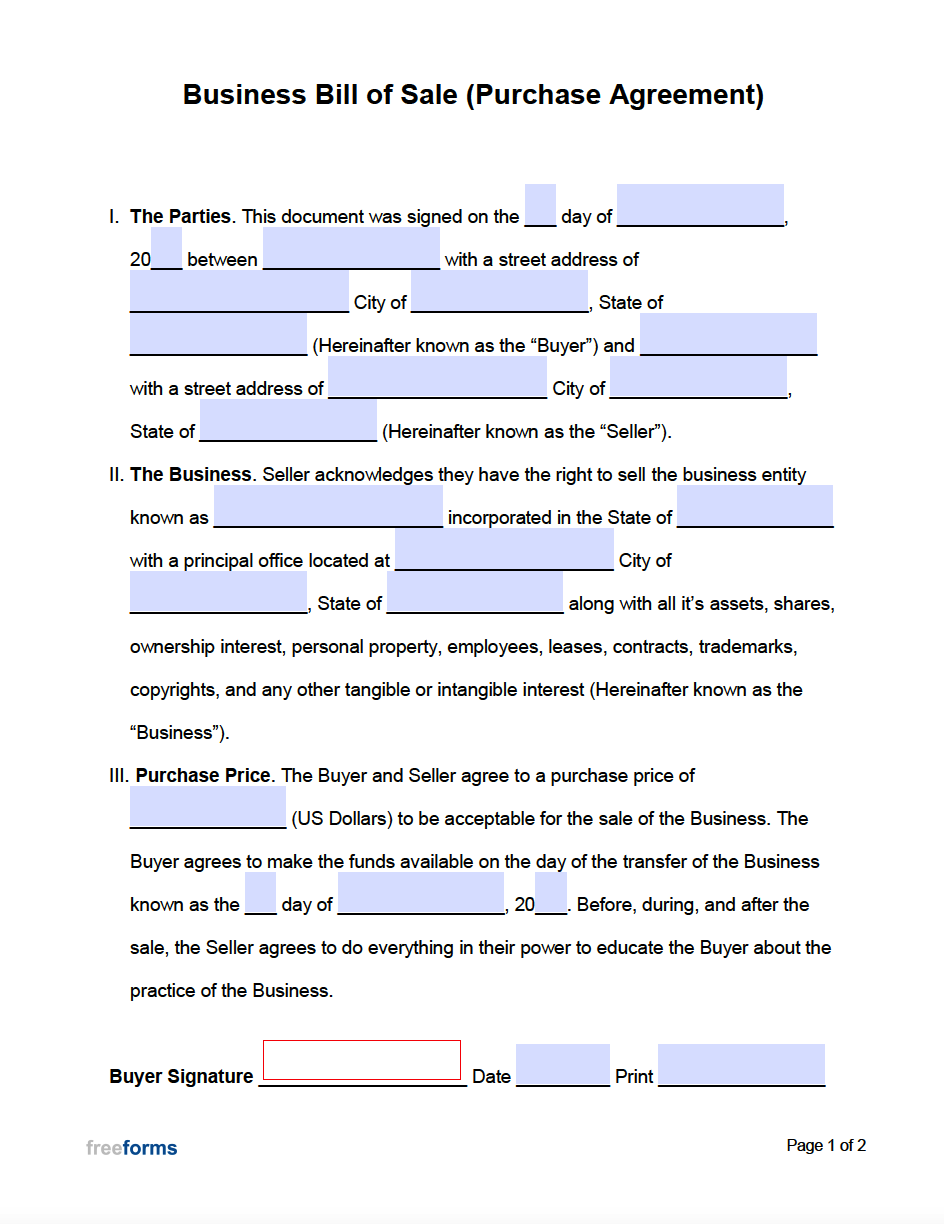A Business bill of sale form functions as a written instrument and is used to record the specifics involved within the sale, and the transfer of ownership of a business for stated financial value. This agreement indicates the business being sold and lists the date of sale, the buyer, seller, purchase amount and terms involved with the transfer of the company. Securing a contract testifying to the transfer of a company will serve both the buyer and seller down the line to protect both against any liability malfeasance.
Why Is It Important to Prepare a Bill of Sale?
To sell a business, you will need to complete and execute a bill of sale to adequately demonstrate the transfer of ownership. Doing so will be required to obtain necessary permits and for tax purposes as well. A Purchase Agreement may accompany it, that will delineate the finer points of the exchange and detail specific provisions of the contract. The task of selling a company is a process that, on average, can take from 6 months to a year and can involve several professionals to get the ball rolling.
How to Sell a Business
Calculate the Value of the Business
Hire an evaluation specialist to gauge a workable estimation of the value of the business. Doing so is usually determined by a number of factors including financial performance, risk, and potential for growth. Depending on the size of your business, hiring a professional to estimate the value may be worth the expense, as it can give an accurate figure that will be backed by a neutral third-party. In the case that you choose to commission a broker to oversee the transaction, they may be able to evaluate the company as well. Also, a broker can bring in buyers, advise in seeking financing and even vet potential buyers. If you already have a possible buyer in mind, you will not need to go the route of securing a broker for the transaction.
Prepare Information for Potential Buyers
Accounting Information
It is advised that you hire a licensed accountant to organize your books and prepare the following documents for possible purchasers:
- Profit and Loss Statements
- Balance Sheet
- Cash Flow Sheet
- Tax Returns (Last 3 Years)
- Bank Statements
Company Details
Arrange materials to give a snapshot of the status of the company and the field of business it corresponds to:
- Company Information Summary
- Security Reports
- Employee List
- Business Bylaws
- Media Accolades
- Evaluation Materials
- Marketing Strategy
- Competitor Research
- Operations Information
- Client Information
Legal Paperwork
You will want to gather and organize pertinent documentation and contracts that are legally required to transfer possession of the business:
- Revenue Documentation
- Profit Reports
- Expense Reports
- Non-Disclosure Agreement
- Letter of Intent
- Articles of Incorporation
- Partnership Agreement
- ROI Analysis
- Supplier Agreements
- Assignment of Licenses
- Assignment of Leases
- Stock Status
- Asset Aquisition Statement
Market the Business to Prospective Buyers
Promoting the sale of your business can be accomplished by creating an advertisement to post in the business classifieds. Whether you post in your area newspaper, online, or both, you will want to include the business type, location, and purchase price. Consider including photos of the business location(s) to give a face to the name and any company details that may attract a buyer. When posting an ad online, many business-specific sites can help you reach a broader range of prospective buyers such as BizBuySell, BizQuest or Business Exits.
Meet With Prospective Buyers and Close the Sale
Once potential buyers show interest, schedule a meeting to promote the sale and highlight the value that the business could bring to an investor. After agreeing, you will want to retain the assistance of an attorney to look over offers, contracts, and agreements to ensure that they are in order and to protect your interests. You can make arrangements with the buyer to determine a realistic closing date, discuss terms to the contracts, and reassignment of associated leases and assets. Bring the completed bill of sale form along with the aforementioned legal documents to finalize and sign the business over.
Complete the Business Bill of Sale Form
Step 1 – Download the Adobe PDF to then complete the prompted information in the provides spaces.
Step 2 – On the first blank, enter the address of the location at which the bill of sale is to be endorsed, and then the date of execution in the next blank as follows:
- Numerical Day
- Written Month
- Numerical Year (Last 2 Digits)
Step 3 – Input the full name of the seller of the business.
Step 4 – Submit the agreed-upon purchase price of the business in both formats:
- Written Purchase Price
- Numerical Purchase Price
Step 5 – On the next allocated spaces you can fill in the following information relevant to the purchase:
- Seller’s Full Name
- Buyer’s Full Name
- Business Name
- Business Address
- Transfer Date
Step 6 – You can then provide the applicable names of the buyer and seller required to properly communicate the all warranties to the exchange and acknowledgment of the transfer’s legitimacy in the following order:
- Seller’s Full Name
- Buyer’s Full Name
- Seller’s Full Name
Step 7 – Once an accord has been achieved and the document thoroughly understood, under the supervision of a notary public, both parties can finalize the text with:
- Seller’s Signature
- Seller’s Printed Name
- Buyer’s Signature
- Buyer’s Printed Name
- Date of Signature
Step 8 – The notary can then complete the paperwork with the corresponding information and endorsements:
- County
- Date
- Notary’s Name
- Seller’s Name
- Notary’s Signature
- Notary’s Printed Name
- Notary’s Commission Expiration Date
- Notary Seal



0 comments
Comments are closed.